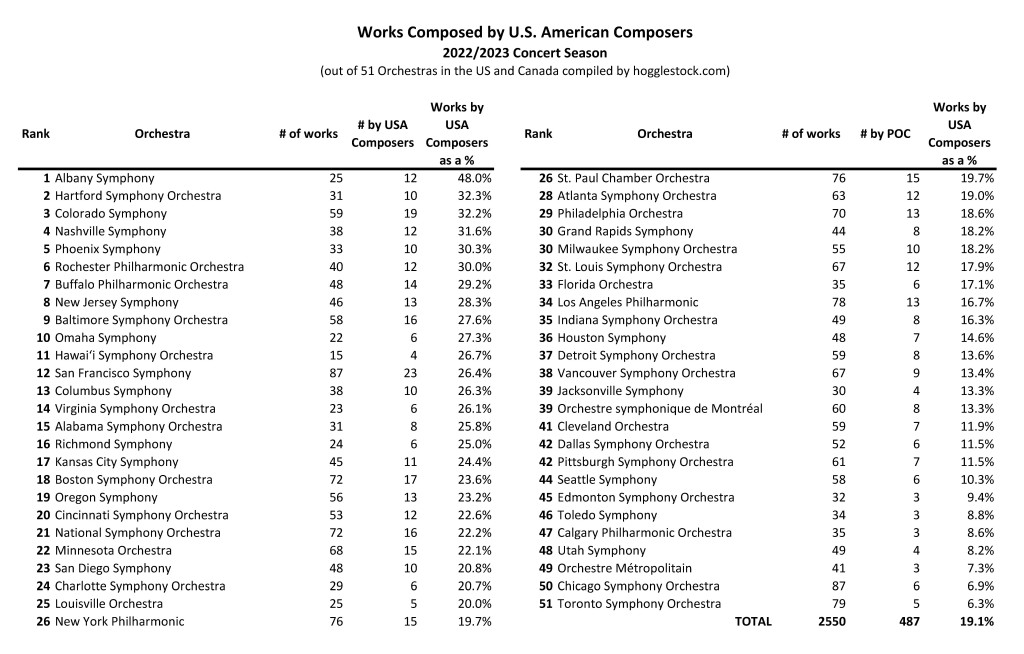[This year I collected and analyzed the subscription concert programming for 51 orchestras in the U.S. and Canada. This is a pretty big expansion from my effort last year when I just looked at the ‘top’ 19 orchestras in the U.S. You can see last year’s posts here and here.]
Sigh. Along with works by BIPOC composers and women composers, the percentage of programming devoted to U.S. composers also declined from 21/22 to 22/23. Last season it was 23% of all programming. Just by looking at the top 20 orchestras, you sure can’t blame the expanded data pool, given that 15 of the top 20 are smaller bands that weren’t part of last years list, and, as you will see further down this post, some of the big guys failed in a really spectacular way.
some observations
First off, I didn’t think it fair to keep the six Canadian orchestras in the mix, so all of the dashboard calculations were based only on the 45 U.S. orchestras in my dataset. Here are some other thoughts:
- How about the Albany Symphony? It’s number one in American music, it was number one in music by BIPOC composers, and it was number nine in music by women composers. They certainly seem like a shoo-in to come up as the orchestra with the most diverse programming.
- The little guys in general. What is it about smaller markets that seem to respond better to more diverse programming in general, and in this case, a warm embrace of American music. This year the lowest percentage to make it into the top 20 was 22.6%. Last year that score would have gotten you into the top 10.
- Only one of the small guys, Phoenix, relies a bit too much on the BBC (Bernstein, Barber, Copland) to earn their spot on the list. Not that there is anything wrong with any of those composers, they just tend to be the ones that crop up when someone says American composer..
- It does appear that orchestras are using their American programming to come up with a fair chunk of their programming of both BIPOC and women composers. Perhaps it means that the US is a hotbed for encouraging BIPOC and women composers, or perhaps, more cynically, orchestras don’t want to chip away at the market share they give dead, white, European guys.
time to clean house
For each of the categories I have looked at so far, it’s clear that some orchestras could really benefit by looking somewhere other than Europe for their programming and their leadership. I’m tired of the cult of the composer and the maestro. Many of these idolized men are brilliant, but hype begets hype, and I find knee-jerk veneration of all things European in the musical context really boring. (And trust me I LOVE Europe–even the UK bit.)
And this is no more evident than in the hall of shame. These fine orchestras are devoting less of their seasons to U.S. American composers than the Canadians. What’s up with that?
canadian music
Since I added in six Canadian orchestras this season, I would be a true chauvinist if I didn’t say something about music by Canadian composers. Nine U.S. orchestras have all programmed one piece by Canadian composers (Albany, Boston, Cleveland, Kansas City, Milwaukee, NSO, New York, Pittsburgh, and Toledo). Among the Canadian orchestras, Orchestre Métropolitain leads the pack with 26.8% of their programming devoted to Canadian composers, then Calgary at 20%, Toronto at 13.9%, Vancouver 9%, Montréal 6.7%, and Edmonton 6.3%.
With Samy Moussa and Iman Habibi leading the pack with five pieces each, other Canadian composers who get multiple plays next season include, Alan Gordon Bell, Vivian Fung, Stewart Goodyear, and Rita Ueda. I must admit Samy Moussa is the only one I knew prior to crunching this data. I had come across and fell in love with a recording by the Orchestre symphonique de Montréal of his work for organ and orchestra, A Globe Itself Infolding. One of the few pieces in the repertoire that effectively integrates organ into the orchestral texture. It also got a play at the Proms a season or two ago.


